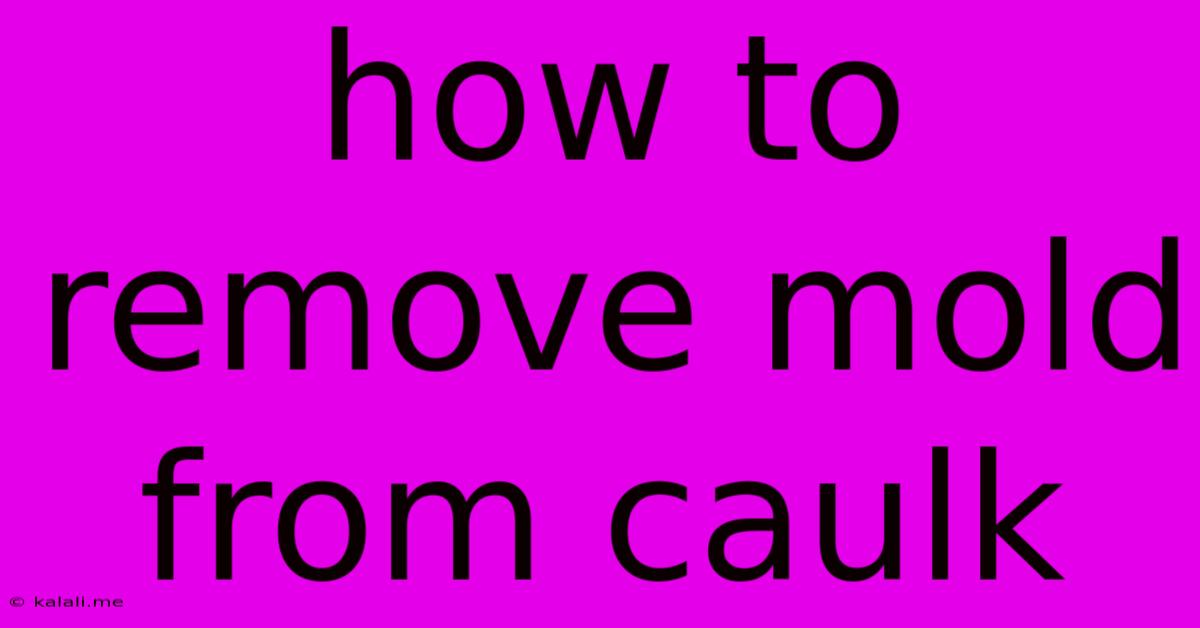How To Remove Mold From Caulk
Kalali
Jun 03, 2025 · 3 min read

Table of Contents
How to Remove Mold from Caulk: A Comprehensive Guide
Mold in caulk is a common household problem, unsightly and potentially harmful to your health. This guide provides a step-by-step approach to safely and effectively remove mold from caulk, restoring the aesthetic appeal and hygiene of your home. Ignoring mold growth can lead to further deterioration of your caulk and potential health issues, so tackling it promptly is crucial.
Understanding Mold Growth in Caulk
Mold thrives in damp, dark environments, making caulk—often found in bathrooms and kitchens—a prime location for growth. Leaks, condensation, and poor ventilation all contribute to the ideal conditions for mold spores to germinate and form visible colonies. The most common types of mold found in caulk are black, green, or white, though the color doesn't always indicate the toxicity. Early detection and prompt removal are key to preventing further spread and potential health risks.
Assessing the Mold Infestation
Before starting the cleaning process, evaluate the extent of the mold. A small patch of mold can often be cleaned effectively, but extensive growth might require replacing the caulk entirely. If the mold has penetrated deeply into the surrounding materials, you may need professional help. Consider the size and severity of the mold infestation to determine the best course of action.
Materials You'll Need
To effectively remove mold from caulk, gather these essential supplies:
- Safety Glasses: Protect your eyes from splashing cleaning solutions.
- Rubber Gloves: Prevent skin irritation from contact with cleaning agents and mold.
- Dust Mask: Essential to avoid inhaling mold spores, especially with larger infestations.
- Cleaning Solution: A mixture of bleach and water (1 part bleach to 10 parts water) is commonly used; consider using a commercially available mold cleaner for a more convenient solution. Vinegar is a natural alternative, though it might be less effective on stubborn mold.
- Stiff-Bristled Brush: A toothbrush or small grout brush works well for scrubbing.
- Putty Knife or Scraper (optional): Useful for removing loose or severely affected caulk.
- Shop Towels or Rags: For wiping away the cleaning solution and mold.
- New Caulk (optional): If the caulk is severely damaged, replacing it is the best option.
Step-by-Step Mold Removal Process
- Preparation: Protect yourself by wearing safety glasses, rubber gloves, and a dust mask. Ventilate the area well to minimize mold spore inhalation.
- Cleaning: Apply your chosen cleaning solution to the affected caulk using a brush or spray bottle. Let it sit for several minutes to allow the solution to penetrate the mold.
- Scrubbing: Gently scrub the caulk with a stiff-bristled brush to loosen and remove the mold. For stubborn mold, you might need to repeat the application and scrubbing.
- Rinsing: Wipe away the cleaning solution and dislodged mold with a damp cloth or sponge. Ensure the area is thoroughly rinsed to remove all traces of the cleaning agent.
- Drying: Allow the area to dry completely before re-caulking or resuming normal use.
- Caulk Replacement (if necessary): If the caulk is significantly damaged or mold has penetrated deeply, replace it with new caulk. Properly prepare the surface before applying the new caulk to ensure a good seal.
Preventing Future Mold Growth
Preventing mold growth is as important as removing it. These preventative measures can significantly reduce the chances of recurrence:
- Improve Ventilation: Ensure proper ventilation in areas prone to moisture buildup, such as bathrooms and kitchens. Use exhaust fans during and after showering or cooking.
- Address Leaks: Repair any leaks promptly to prevent water damage and mold growth.
- Reduce Humidity: Use a dehumidifier in damp areas to control humidity levels.
- Regular Cleaning: Regularly clean caulked areas to prevent mold accumulation.
By following these steps and implementing preventative measures, you can effectively remove mold from caulk and maintain a healthy and aesthetically pleasing home environment. Remember, if the mold infestation is extensive or you're unsure about handling it yourself, it's best to consult a professional mold remediation specialist.
Latest Posts
Latest Posts
-
Do People Use Mayonnaise For Potato Salad Spain Google Ai
Jun 05, 2025
-
One Will Be Taken And The Other Left
Jun 05, 2025
-
Blue Snowball Setting 1 2 3
Jun 05, 2025
-
Scores Can Be Assumed To Be Symmetric Meaning
Jun 05, 2025
-
Part Of The Outside Of A Hose
Jun 05, 2025
Related Post
Thank you for visiting our website which covers about How To Remove Mold From Caulk . We hope the information provided has been useful to you. Feel free to contact us if you have any questions or need further assistance. See you next time and don't miss to bookmark.